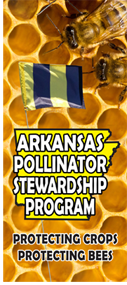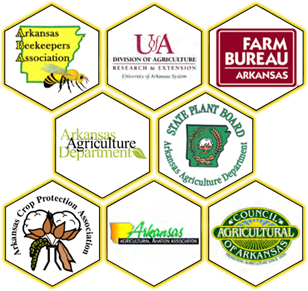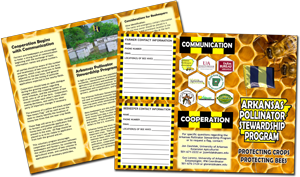Contact
Assistant Professor of Apiculture & Urban Entomology
Phone: 501-671-2222
Fax: 501-671-2252
Email: jzawislak@uada.edu
Web: uaex.uada.edu/bees
University of Arkansas System
Division of Agriculture
Cooperative Extension Service
2601 N. Young Ave.
Fayetteville, AR 72704
 Arkansas Pollinator Stewardship Program
Arkansas Pollinator Stewardship Program
What are the goals?
The Arkansas Pollinator Stewardship Program seeks to minimize economic losses for both farmers and beekeepers by adequately managing row crop pests while minimizing impact of pesticides on honey bee colonies.
Why was the program created?
In light of declining honey bee populations worldwide, representatives of Arkansas’ agricultural producers and beekeepers have developed a set of standard practices to encourage cooperation and communication between growers, pesticide applicators, and beekeepers.
What role do bees play in food production?
Many beekeepers are also multi-generational farm families. Their livestock may be small, but their honey bees play a vital role in our food production. Bee pollination improves the yield and quality of farm products, and adds billions of dollars to the U.S. economy.
Transporting bees - how does it help?
Arkansas honey bee hives may be trucked to many other places to provide pollination for important crops. These same bee colonies rely on our state’s vast agricultural landscape to maintain them while not on the move. While some of our state’s crops may not rely on bee pollination, cooperation between Arkansas growers and beekeepers helps to keep food on the table for all Americans.
Cooperation Begins with Communication

Farmers and beekeepers are encouraged to foster a strong level of communication beginning with the exchange of basic information: names and phone numbers.
Flagging bee location and the communication process
This voluntary program encourages cooperation and communication between beekeepers and farmers, by considering the careful placement of bee colonies in agricultural areas, and carefully timing applications of necessary pesticides.
- All parties should be aware of the number and locations(s) of bee hives on the farm property, which crops are grown in fields adjacent to the bee hives, and general information on the timing of pesticide applications expected in the nearby fields.
- Cooperators should keep an open dialogue during the growing season regarding changes within the cropping system or spray schedule, and the movement of bee hives onto or off of the farm.
- Cooperators should consider each other’s needs when making decisions, and notify the other party of important changes if necessary.
- The presence of a yellow and black striped Bee Aware Flag will be used across the state to clearly identify the locations of honey bee hives that are near crop fields.
- These flags will serve as a visible reminder to farmers and pesticide applicators that honey bees and other pollinators are present in the area.
- All flags should be placed so as to be visible to applicators from both the ground and air, similar to other flags commonly used in Flag the Technology programs around the state.
Considerations for Beekeepers
Hive Identification:
The name and emergency contact information for the hive owner should be placed in
a highly visible and prominent location in the apiary, as well as being on file at
the farm headquarters.
Bee Flag Placement:
All parties should work together to select a prominent location for the Bee Aware
Flag that will be visible to applicators from the air or ground.
Apiary Locations:
Farmers and beekeepers should cooperate to select apiary sites that maximize protection
to bee hives, while minimizing risk of direct hive exposure to pesticide sprays. Maintain
a current and comprehensive list of all apiary locations on the property. This may
be particularly important if hives are moved. It may be helpful to mark apiary locations on a map or provide GPS coordinates to show exact locations of the
hives on farm property.
Considerations for Farmers
Notification of Applicators:
Farmers should make all employees (or contractual parties) aware of all apiary locations
and the associated Bee Aware Flags on the property. Aerial applicators should also
be made aware, if necessary.
Timing of Pesticide Applications:
Whenever possible, growers should consider applying pesticides as late as possible
in the afternoon, particularly when a crop is in bloom, or to fields that are adjacent
to honey bee hive locations.
Wind Direction:
Applications should only be made when wind conditions will not promote excessive spray drift, and ideally when winds are blowing away from hives.
Watch a brief overview of the program from Arkansas Land & Life 6-19-15.
|
 |
More information
For specific questions regarding the Arkansas Pollinator Stewardship Program, or to request a flag, contact:
Jon Zawislak
University of Arkansas Extension Apiculturist
501-671-2222 or jzawislak@uada.edu
Honey bee hive pest and disease treatments (MP-144)
Relative toxicity of pesticides to honey bees


